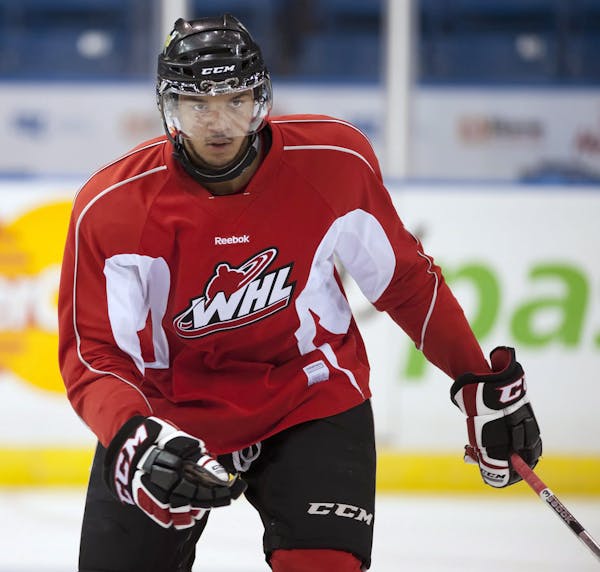NEW YORK – In the 21st century, it's all about technology. But Chuck Fletcher likes to keep things simple.
That's why the Wild general manager rarely goes anywhere without his trusty black Cambridge notepad.
Inside, Fletcher keeps all his trade secrets — literally.
After every single trade conversation Fletcher has with a fellow GM, Fletcher opens up the notebook and jots down the ideas exchanged.
"This way you don't forget," Fletcher said. "There are so many variables and moving parts to every conversation you have, you need to have a quick, easy way to keep track. I have conversations in here that I had four or five years ago that I'll re-read and think, 'Geez, I didn't even remember that.' "
As Sunday's NHL draft arrives at the Prudential Center in Newark, N.J., it is safe to say Fletcher has been sharpening his pencil a lot lately.
The draft is most significantly about adding an influx of 18-year-old talent to the pool of prospects, but it also triggers the start of offseason transactions in the NHL. Fletcher has a history of trades at or around the draft (from moving up and down in the draft to executing blockbusters like the Brent Burns deal to setting up the Martin Havlat-for-Dany Heatley swap).
These days, Fletcher says he's making as many calls as he's receiving.
There is a very likely chance Cal Clutterbuck's time with the Wild ends Sunday. The Wild has gotten a lot of interest for the 25-year-old restricted free agent. The Wild would prefer to trade him to the Eastern Conference (Toronto, Pittsburgh and Columbus, which has three first-round picks, are teams that have expressed interest).
The Wild has dangled other players as well, from defenseman Tom Gilbert to center Zenon Konopka. It also has received calls about Devin Setoguchi and Kyle Brodziak.
Scouts say this is as deep a draft as there has been in 10 years. Because the Wild traded its first-round pick to Buffalo in the Jason Pominville deal, the Wild doesn't choose first until the 46th pick.
In a package for Clutterbuck, the Wild would love to land another second-round pick so it can try to package two seconds and move into the first round — likely in the Nos. 15 to 30 range. So it can be ready, the Wild has debated and prepared its draft list as if it still has a first-rounder.
"Often two seconds can get you into the first round, or it can be a second and a player. Sometimes it can be a prospect," Fletcher said. "We'll see what happens. If we can't do it, I'm comfortable because this is a deep draft. We have two thirds. Some years it's a shallower pool and an extra third may not mean anything, but I think this year it'll be a little more meaning."
If the Wild can't move into the first round, it'll be the first time in history it doesn't own a first-round pick. That's why it's critical to hit on its later picks.
"We pick 46 this year. We picked 46 last year and got [Raphael] Bussieres," Fletcher said. "We were really happy with Bussieres, but after him, there was a big drop-off. I think this year there will be more options when we pick at 46, and I think that'll extend into the third round."
Other than 2000 second-rounder Nick Schultz, the all-time leader in Wild games played (743), the Wild hasn't hit on many players after the first round. As of now, Clutterbuck (72nd overall in 2006) is clearly the biggest post-first-round home run.
From 2000-08 — under the Wild's previous regime — the only post-first-rounders to play more than a handful of games for Minnesota were Stephane Veilleux and Derek Boogaard (2001), Josh Harding (2002), Clayton Stoner (2004) and Justin Falk (2007). The Wild still expects 2008 second-rounder Marco Scandella to make an impact.
Things have looked up with the new regime, but it's still too early to say concretely.
The promising names still part of the franchise include Darcy Kuemper and Erik Haula (2009), Brett Bulmer, Jason Zucker and Johan Gustafsson (2010) and Mario Lucia, Nick Seeler and Tyler Graovac (2011). The Wild also is high on its 2012 draft class beyond first-round pick Matt Dumba.
"The stats we've looked at every year is about 1.9 players per draft per team play 80 or more games in the NHL," Fletcher said. "Basically if you're drafting two NHLers, you're treading water, you're doing what you have to do.
"Our goal has always been to draft three or more. It's hard. You can't do it every year. This year without a first, it'll be challenging, but we have eight picks, we have an extra third, and the second-round pick this year is probably better than a lot. So that's still going to be our goal. That's the goal I've asked of [assistant GM Brent Flahr] and our scouts.
"We still have to aim high."
Collin Morikawa part of 4-way tie for the lead at Hilton Head. Scottie Scheffler lurks 3 shots back
Nuggets forward Michael Porter Jr. heads into playoffs against Lakers after trying week for family
Jameson Taillon comes off the injured list and pitches Cubs to 8-3 win, dropping Marlins to 4-16

